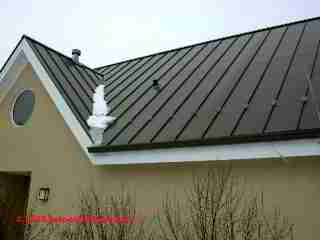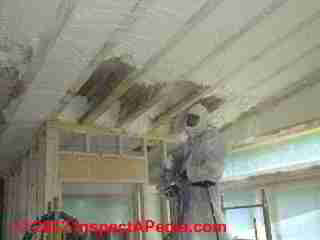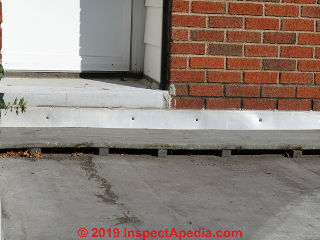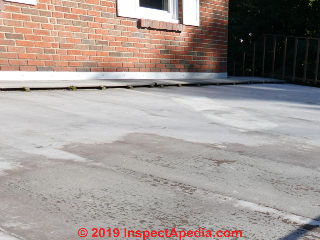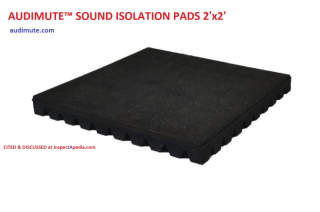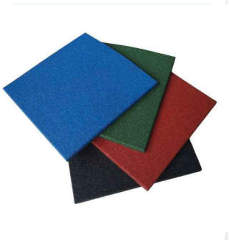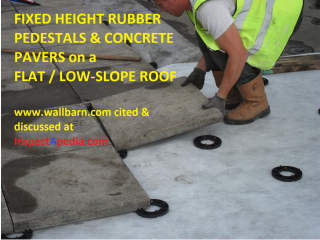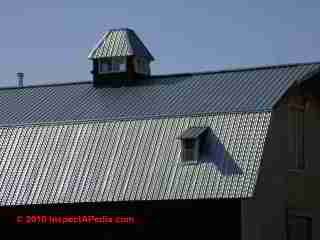 How to Diagnose, & Repair Roof & Structure Noise Problems in Buildings
How to Diagnose, & Repair Roof & Structure Noise Problems in Buildings
- POST a QUESTION or COMMENT about building roofs & noise or sound transmission or noises coming from roofs themselves
Roof & building structural noise transmission &control, causes & cures:
How does exterior noise (rain, hail, highways, aircraft noise) transmit through a roof to the building interior and how can we soundproof building roofs for a quiet building interior?
These articles discuss building noise control: how to inspect, diagnose & cure noise or sound problems in homes or commercial buildings.
Information is provided about auditory (hearing), visual, historic, medical, or other clues of building condition that explain various sounds heard in buildings. We also discuss methods of sound or noise control in buildings during construction or as a building retrofit.
InspectAPedia tolerates no conflicts of interest. We have no relationship with advertisers, products, or services discussed at this website.
- Daniel Friedman, Publisher/Editor/Author - See WHO ARE WE?
Roof & Structure Noise Transmission & Structural Noises in buildings: Sources, Causes, Remedies
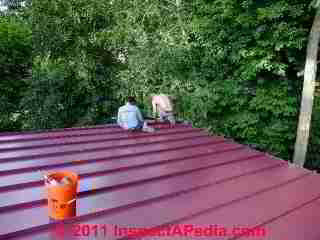 This article discusses types of noises produced in, on & around building roofs, noise and sound transmission, causes and cures.
This article discusses types of noises produced in, on & around building roofs, noise and sound transmission, causes and cures.
Article Series Contents
- CATALOG of ROOF NOISES
- ROOF COVERING MATERIAL ROLE IN NOISES
- METAL ROOF UNDERLAYMENTS
- METAL ROOF PROFILE vs NOISE
- METAL ROOF FASTENERS vs NOISE
- METAL ROOF NOISE REDUCTION MEASURES
- ROOF IMPACT NOISE: ACORNS ANIMALS HAIL RAIN
- SHINGLE FLAPPING POPPING SNAPPING CAUSE & CURE - separate article
- POPPING SNAPPING NOISE DIAGNOSIS - separate article
- SOUND TRANSMISSION CLASS STC & OITC
- TRUSS UPLIFT, ROOF
- TEMPERATURE CHANGE & ROOF NOISE - separate article
- WIND NOISES ON ROOFS - separate article
A Catalog of Types of Roof Noises & Sounds
Roof noises may be described as those attributed to an obvious source: the patter or even the roar of falling rain or hail, popping and cracking noises (perhaps due to thermal expansion and contraction of roof coverings, metal roofing, or roof structure), and transmitted noises from other external sources such as low-flying aircraft or nearby trains or auto & truck traffic from a nearby highway.
Very loud roof "booming" noises may be heard in cold climates when water freezing on a flat or low slope roof becomes cold enough to fracture.
Other noises sometimes attributed to building roofs are actually traced to other building components on or near the roof, such as antennas, wires, cables, signs, and roof-mounted equipment.
Also see BANGING BOOMING NOISE DIAGNOSIS & CURE
Are metal roofs more noisy than other roof covering types?
Metal-covered roofs in modern building installations are not necessarily noticeably noisier than other roof covering types - depending on the choice of type of metal roofing, underlayment, roof decking, fastener method, and roof insulation method.
Therefore when investigating a specific roof noise complaint it makes sense to first understand how roof noise is transmitted to the building interior and second to check the most-common roof noise sources such as thermal movement, fastener errors, underlayment errors, or rain and hail noise transmission through or around insulation to the building interior.
The metal roof home shown in our photo (left, courtesy Galow Homes), was installed on a New York home and used solid metal plywood roof decking.
The roof framing support is comprised of I-joists, and the roof cavity is insulated with blown-in foam. During heavy rain, from inside the space below the roof, we could hear only a very muted sound of rainfall on the roof surface and in our opinion the sound level was not different than under an asphalt-shingle roof of similar design and use.
Nevertheless, reader questions & comments as well as our own field experience make clear that some metal roofs and some roofs covered with other materials can be very noisy and at some buildings there are serious occupant complaints about roof noise levels observed at roofs of various designs and materials.
How is Roof Noise Transmitted into a Building?
 Regardless of their source, roof noises are transmitted into buildings by two methods.
Regardless of their source, roof noises are transmitted into buildings by two methods.
- Airborne Sound: Sound waves traveling through air move between building areas - such as through open windows, doors, or stairwells.
- Mechanically transmitted sound: When sounds move through solid building components such as floors, ceilings, walls, framing, carrying sound from one area to another the sound transmission is referred to more technically as impact insulation class transmission or IIC sound transmission.
Certain building configurations, such as occupied attics or under-roof areas with cathedral ceilings, low slope or flat roofs, and metal roofed buildings may transmit noises to the building interior through the roof sheathing and building framing.
Where roof-transmitted sound reduction is most sought is in buildings located close to high noise areas such as under the flight path to airports.
Our photo of metal roofed homes (left) shows two older houses in Key West, Florida.
Role of Roof Covering Material in Noise Transmission
Choice of roof covering affects roof noise:
Choices of roofing materials can reduce roof transmission of sound to the interior, including use of bituminous or asphalt shingles, or more effective, higher-mass roofing materials such as roofing tiles of clay or concrete.
Metal roofing can be sound-transmission reduced by installing the metal roof over plywood and solid foam insulation. Keep in mind that roof skylights are likely to increase sound transmission through roofs.
Green roofs reduce roof noise transmission:
One of the benefits claimed for "green roofs" is that by virtue of their stiffness and high mass, green roofs provide very good resistance to sound transmission from outside the building. Quoting:
Green roofs can provide a higher [noise] transmission loss than the additional ceiling element and improve [sound] transmission loss throughout the full architectural frequency range, specifically desirable in residential occupancies below aircraft flight paths.
The field testing conducted on two 33 m2 low profile extensive green roofs indicated an increase of 5 to 13 db in [sound] transmission loss over the low and mid frequency range (50 Hz to 2000Hz) and 2 dB to 8dB increase in [noise] transmission loss in the higher frequency range relative to the transmission loss [sound transmission resistance] of a reference roof. - Connelly & Hodgson, [1]
Connelly & Hodgson reference Dr. Ben H. Sharp, an expert in sound transmission through structures who developed sound transmission theory and who proposed (Sharp 1973) improvements to roof sound transmission resistance thorough roof/ceiling assemblies that combined increased mass with low stiffness.
Accurate diagnosis of the source of roof noise transmission
is important in deciding what remedy may work best. For example, check during rainfall to accurately determine the loudest sound source - you might find that more noise is transmitted to the building interior through skylights than through the roof surface itself.
Below at our roof noise FAQs we suggest investigative steps useful in diagnosing and thus curing annoying roof noises & sounds.
Metal Roof Noises & Roof Underlayments: Rain, Hail, Thermal Movement
Depending on installation details, metal roofing can transmit rain noise into buildings at levels exceeding 70 dB (equivalent to street traffic noise).[2]
Noise generated by the roof covering material itself may be a factor where metal roofing is installed, particularly if the metal roofing is not properly insulated and if its connections to the roof deck fail to secure the material properly, including providing an allowance for movement.
A 10-meter metal roof panel can easily have 8 mm. of thermal expansion over its length. (NZSteel Company 2005)[6].
Quoting from another source: :
Enkamat underlayment and composites made with Enkamat reduce sound levels from 9.5 to 13.5 decibels compared to a metal roof directly over a weather barrier fabric.
When the
entangled filament underlayments were combined
with a gypsum ceiling and thermal insulation
the sound reduction further increased to
21.5 decibels. When considering that a sound
reduction of 10 decibels is perceived by the
human ear as cutting noise levels in half, a
reduction of over 20 decibels is significant. (Colbond 2011 [2])
As we explain at METAL ROOF EXPOSED FASTENER FLASHING
One frequently cited disadvantage of metal roofing is that it generates a noticeable noise when struck by rain, hail, or even dropping acorns.
If installed directly to purlins with no roof sheathing, the noise might be heard in the building interior.
However, when installed over a solid substrate, with normal levels of insulation, the noise should not be noticeably different than with other roofing types.
Suggestions for reducing rain, hail, or thermal movement noises in roofs are given in this article.
The Role of Metal Roof Profile Type in Roof Noise Levels
The metal roof profile type may also affect the level of noise transmitted by the roof to the building interior. Raised profile metal roofs may be noisier than a flatter profile roof on the same building.
Metal roofing that is supported directly by the roof deck below will deflect less and should be more noise and sound resistant than metal roofing that has a raised profile. For example, some metal roof shingles employ a raised profile that includes an empty air space below the metal shingle surface.
The Role of Metal Roof Fasteners in Roof Noise Levels
Because improper choice of fastener, improper fastener location, or improper number of fasteners may permit metal roof components to move in ways that increase the roof noise level during temperature changes, review the manufacturer's specifications for your particular roof product to be sure that the roof was installed as recommended.
Check panel lengths, panel side-interconnections, fastener type, size, interval, location, and any other fastener and panel specifications in the roofing manufacturer's product installation guide.
Pay particular attention to panel end abutments against immovable surfaces.
A roof panel, even a fairly short one, that tightly abuts a vertical surface such as a chimney, wall or parapet, may be noisy when heated by normal temperature changes.
Watch out: be sure that your metal roof fasteners are installed following the metal roof and fastener manufacturers' instructions including the fastener hardware (the fastener screw itself as well as any rubber or lead or other washer required by the fastener and roof manufacturer), fastener spacing and fastener tightness.
If your metal roof is not well secured to the roof decking it may produce noise under changing temperatures, wind, rain, hail, even changes in outdoor humidity or sun exposure, all of which might have been avoided.
Suggestions for Reducing Noise Transmission Through Metal-Covered & Other Roofs
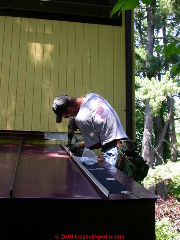 These metal roof installation options can reduce roof noise transmission from metal roofs, such as the sound from falling rain or hail:
These metal roof installation options can reduce roof noise transmission from metal roofs, such as the sound from falling rain or hail:
- Re-roofing with metal roofing over existing asphalt shingles, if permitted by local building codes, will afford some sound insulation.
- Install metal roofing over sound-absorbing foam insulating panels to reduce noise transmission through the roof to the building interior.
- Installing metal roofing over an insulated attic space will transmit less noise to the building interior than installing a metal roof over a flat or low slope roof that does not include an insulated attic space between the roof and the occupied space.
- Install metal roofing over plywood or OSB - even if your building structure permits installing a metal roof over spaced nailers, doing so will pertty much guarantee an incredible racket during rain or hailstorms.
- Install metal roofing over sound-deadening underlayment products designed to permit ventilation and whose properties also are sound-isolating.
Among the examples of sound-deadening roof underlayments that we list below in this article, examples include Colbond underlayments and Enkamat 7008/1010 reduce the sound transmission of the impact noise of rainfall or hail on metal roofing. - Selecting a heavily-formed, heavily profiled, or textured metal style roof product may reduce its noise transmission property.
Photo: Eric Galow installing the last course of fasteners on this standing seam metal roof in Poughkeepsie, New York.
- Use the proper metal roof fasteners, as we detailed above on this page: metal roof fasteners mustd be located in the right location, and at the right interval as specified by the roofing manufacturer.
Too few fasteners, or loosely-fastened or improperly secured metal roofing or using the wrong screws or omitting washers (if specified) is likely to mean that your metal roof will be more noisy as temperatures vary and as it's pelted by rain, acorns, or hail.
See STANDING SEAM METAL ROOF INSTALLATION for details about standing seam roof installation, flashing, maintenance, repair.
See
Smith, Thomas L., AIA, CRC, METAL ROOFING: 'FIXING' for THERMAL MOVEMENT [PDF] NRCA, National Roofing Contractors Association - Use multiple layers of building insulation under the roof, tight construction, and sealants in gaps or sound transmission pathways - NAIMA [4] quoted just below.
Adding faced metal building insulation alone to the metal building construction can reduce noise levels in a metal building by 5-6 dB. However, construction techniques do impact the way sound travels.
To maximize a metal building’s acoustical performance, the wall and/or roof panels should include at least one layer of faced metal building insulation, and one layer of unfaced metal building insulation.
Additionally, the construction should be tight, with attention to detail such as filling gaps with flexible sealants to assure that sound does not transit via air leaks from one space to another. - NAIMA [4]
Some writers assert that mineral wool insulation or "glasswool" insulations are particularly effective at noise control.
See MINERAL WOOL - ROCK WOOL INSULATION
We have had excellent noise and sound control results under a metal roof whose roof cavity below was insulated with spray-foam insulation.
Above: spraying foam insulation under this low slope metal roof proved an effective sound control measure.
- Insulate the ceiling space below the metal roof, as we've explained above, as a sound-control measure.
- Use acoustic mat walking surfaces on flat & low-slope rooftops.
There are a number of producers of high-impact acoustic mats & roof pads or panels intended to protect flat & low-slope roof membranes from damage by foot traffic.
Some of these pads and panels have good noise attenuation properties.
Be sure to review your intended use with the acoustic mat or roof walking surface pad manufacturer. - Identify Noise Transmission Pathways between the roof and the occupied space and seal them with acoustic sealants or possibly acoustic or sound-absorbing weatherstripping tape. Chimney penetrations and sometimes plumbing penetrations can be sound transmission pathways.
See details at FLANKING SOUND PATHWAY CUT-OFF
Acoustic & Noise Reduction Research & Products for Roofs
- InspectApedia articles on metal roof noise control include:
ROOF IMPACT NOISE: ACORNS ANIMALS HAIL RAIN
METAL ROOFING - topic home
METAL ROOF EXPOSED FASTENER FLASHING
[1] Connelly, Maureen, Hodgson, Murray, "Thermal and Acoustical Performance of Green Roofs", Sound Transmission Loss of Green roofs, [presentation, Session 1.5], Greening Rooftops for Sustainable Communities, conference, awards, trade show, Baltimore MD, 30 April-2 may 2008. Web search 4/3/2011 original source: http://commons.bcit.ca/greenroof/publications/
2008_grhc_connelly_hodgson.pdf.
These authors provide an excellent bibliography of references for sound transmission in buildings, including some of the references cited just below:- Sharp, BH 1973, Study of Techniques to Increase the Sound Insulation of Building Elements. U.S. Department of Commerce PB-222 829, Washington.
- Sharp, BH & Martin S 1996, "The Measurement of Aircraft Noise Reduction in Residences", Proceedings of Inter-Noise, Liverpool, 1996, pp. 2747-2752.
- Friberg, R 1973, "Transmission Loss and Absorption Factors for Corrugated Steel Roofs, Insulation on the Outside", Proceedings of Inter-Noise, Copenhagen, 1973, pp. 213-217.
- [2] Colbond, EnkaTech Note, ACOUSTICAL BENEFITS OF ROOF UNDERLAYMENTS [PDF] Colbond Inc., PO Box 1057, Enka NC 28728, gtel: 800-365-7391, website: www.colbond-usa.com web search 4/3/2011, original source: http://products.construction.com/
swts_content_files/1329/E835617.pdf - [3] General Steel Corporation, "The Facts About the Acoustical Performance of Metal Building Insulation 2", Sound Transmission Class, General Steel Corporation, 10639 W. Bradford Road, Littleton, CO 80127, web search 4/3/11, original source: http://www.gensteel.com/insulation_facts-5a.htm
- [4] North American Insulation Manufacturers Association NAIMA, INSULATION FACTS #58: THE FACTS ABOUT THE ACOUSTICAL PERFORMANCE OF METAL BUILDING INSULATION [PDF] , NAIMA, 44 Canal Plaza, Suite 310, Alexandria VA 22314, tel: 703-684-0084, website: http://www.naima.org/
- [5] Booming roof noises in Northern Minnesota caused by freezing water and ice fracturing, personal communication, JC to DF, 12/8/2011
- [6] "New Zealand Steel Installers Guide, COLORSTEEL®, ZINCALUME® steel and GALVSTEEL™ Installer's Guide", [PDF], New Zealand Steel Limited, Private Bag 92 121, Auckland, New Zealand. Tel: 0800 100 523, or 0-9-375 8999 Fax 0-9-375 8213, Website: http://www.nzsteel.co.nz/, Email: info@colorsteel.co.nz - retrieved 2015/12/07, original source: http://www.nzsteel.co.nz/content/media/ 77012/New%20Zealand%20Steel%20Installers%20Guide%20-%20November%202005.pdf
- Barrier Ultra-R super high-R building panels, produced by Glacier Bay, use Aerogel and are rated up to R-30 per inch, or in Barrier Ultra-r™ panels, R-50 per inch.
The company also produces acoustic panels that are Ultra-db resistant and lightweight. Unlike the appliance insulation panels discussed in the original Q&A above on miracle insulation, these Areogel based panels will continue to retain some, though reduced insulating value if punctured, performing at perhaps R-9 per inch.
The product is used in marine refrigerators, but in the future may be available as a residential construction product. The company is researching specialized products in medical, transportation, and aerospace applications. Contact: Glacier Bay, Inc., 2930 Faber Street, Union City, CA 94587 U.S.A., (510) 437-9100, Sales and Technical Information - sales@glacierbay.com - Tremco, Tremco Global Sealants Division, 10701 Shaker Blvd., Cleveland OH 44104 - see www.tremcosealants.com/
- Ideal Tape, Inc., 1400 Middlesex St., Lowell MA 01853 - see www.abitape.com/tape/iframe_ideal.htm Tel: 1-800-284-3325
- 3-M Corporation, tape products, see solutions.3m.com/
- US EPA Noise Regulations & References
- 42 USC 4901-4918 Index - Noise Control act - original source: http://www.nonoise.org/epa/act.htm
- Federal Regulations from the EPA's Office of Noise Abatement & Control - http://www.nonoise.org/epa/reg.htm
- A Basis for Limiting Noise Exposure for Hearing Conservation [PDF] U.S. EPA, original source: http://www.nonoise.org/epa/Roll1/roll1doc1.pdf
- Noise - a Health Problem - http://www.nonoise.org/library/epahlth/epahlth.htm - quoted below
Racket, din, clamor, noise. Whatever you want to call it, unwanted sound is America's most widespread nuisance. But noise is more than just a nuisance. It constitutes a real and present danger to people's health. Day and night, at home, at work, and at play, noise can produce serious physical and psychological stress. No one is immune to this stress. Though we seem to adjust to noise by ignoring it, the ear, in fact, never closes and the body still responds - sometimes with extreme tension, as to a strange sound in the night.
The annoyance we feel when faced with noise is the most common outward symptom of the stress building up inside us. Indeed, because irritability is so apparent, legislators have made public annoyance the basis of many noise abatement programs. The more subtle and more serious health hazards associated with stress caused by noise traditionally have been given much less attention.
Nonetheless, when we are annoyed or made irritable by noise, we should consider these symptoms fair warning that other things may be happening to us, some of which may be damaging to our health. - Protective Noise Levels - 1979, basis for many local noise ordinances and codes - http://www.nonoise.org/library/levels/levels.htm
This publication is intended to complement the EPA's "Levels Document,"* the 1974 report examining levels of environmental noise necessary to protect public health and welfare.
It interprets the contents of the Levels Document in less technical terms for people who wish to better understand the concepts presented there, and how the protective levels were identified. In that sense, this publication may serve as an introduction, or a supplement, to the Levels Document. - Quiet Communities Act - 1978 [TEXT FILE]
- See additional citations atReferences or Citations
Control of Imact Noise on Roofs: Acorns, Rain & Hail, Seagulls
Below we find reader complaints about noises transmitted into their home's interior when various things impact the flat roof above: from acorns to seagulls and of course including rain and hail.
Here we discuss measures taken to reduce the transmission of roof impact noises into the building interior.
Above: this site-built flat roof walking surface over a New York home used synethtic decking as both sleepers and runners to provide an access walkway across a flat roof up to the home's entry door. This is a modified bitumen membrane roof not intended to withstand regular foot traffic nor the potential damage should occupants place furniture directly onto the decking surface.
The home's owners provided only this walkway and left the rest of the roofing membrane alone - shown below.
Watch out: Be careful about installing any walking system on any membrane roof, GPR or EPDM, modified bitumen, roll roofing, tar & gravel, even metal or other roof coverings, without first checking with the roof manufacturer to be sure you are not doing something that the manufacturer warns will damage the roof or void its warranty.
Question: use rubber play mats to reduce rain and echo noise on a roof?
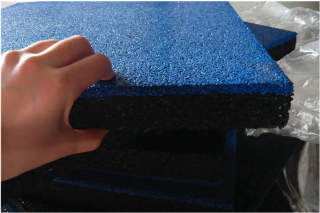 Review roof noise reduction product options with the manufacturer & choose an effective & economical approach
Review roof noise reduction product options with the manufacturer & choose an effective & economical approach
Can and should you try to stop rain noise on a flat roof by using rubber play mats like the ones shown here, laying rubber matting over the entire flat roof surface?
Or is spray foam under the roof an alternative?
A preliminary review of rubber and similar roof paver products did not quickly find any claim for noise and sound reduction or transmission reduction but that might indeed be an effect.
Indeed, properly-selected, rubber pads may be quite effective in reducing impact noise on a roof.
However typical rubber play mat surfaces intended for outdoor exposure are not desogmed for suspension over roof shims off of the roof itself.
There are some risks (roof damage, product failure); be sure to choose a product that is intended for that use, for outdoor exposure, for over-roof application. Furthermore, we ought to be sure we're choosing the roof impact noise control approach most-likely to have success.
Let's get some objective data before going to a lot of expense and trouble.
In some flat roof designs an empty celing space below the roof combined with the drywall ceiling below can act as an echo chamber and noise transmission system not unlike a speaker cone
Get an architect or engineer who has sound control expertise on site before you make a decision on what method to try. Else we're perhaps being a bit hasty in concluding which is the best solution and which simply don't work effectively.
Noise Control for Flat & Low Slope Roofs & Roof Walking Surfaces
Watch out: be sure that the sound-control product you consider is rated and intended for outdoor use on or under roof surfaces; some of our readers have been confused about what products are suitable for roof noise transmission reduction.
That's because some sound reducing and sound proofing products incuding some of those listed here as examples) are intended for interior use and/or for limited area use; for roof noise control consult an engineer or architect with expertise in noise and sound control and be sure that on-roof padding actually makes sense; insulation and sound transmission prevention in roof design may be more effective and more economical.
Example the Peacemaker® soundproofing underlayment is intended for use as a flooring underlayment while the comopany's isolation pads are intended for indoor use in specific applications such as beneath a sub-woofer speaker.
- CMSDanskin Acoustics, offices in North Lanarkshire Scotland, Warrington in southern UK and other locations, Website: http://www.cmsdanskin.co.uk A Danskin rubber walking surface is a glue-down for industrial walking surfaces indoors;
- Peacemaker® Isolation Pads - 2'x2', (shown above) & the following sound-reduction underlayments are sold by a variety of vendors including Audimute™ 23945 Mercantile Road, Suite H Cleveland, Ohio 44122 USA Website: https://www.audimute.com Tel: 1.866.505.MUTE
Note this description from the supplier does not cite outdoor use nor use as a roofing product:
Peacemaker Isolation Pad is a small, yet dense sound isolation material designed to float devices that cause vibration such as speakers, mics, and sub-woofers. Using Peacemaker Isolation Pad will help to decouple items from a surface, reducing vibration transfer. This portable solution is made from recycled materials and is safe for use in commercial or residential spaces. - Peacemaker® Soundproofing Underlayment, 6.4 mm sheeting sold in rolls
Peacemaker® Sound barrier, 3.2mm sheeting sold in rolls
- Slip-NOT, a UK company, also produces sound-deadening and acoustic rubber tiles (shown above) though you'd need to know that they are rated for outdoor use and that the manufacturer of your roof would accept that installation and that the cost and effectiveness are superior to other alternatives such as adding sound insulation and cutting sound transmission pathways into the occupied space.
- SOUND CONTROL for FLOORS - methods that may help with roof noise control
- SOUND ISOLATION STRATEGIES
- Wallbarn, Unit 16, Capital Business Centre, 22 Carlton Rd., South Croydon, CR2 )BS U.K., +44 (0)20 8916 2222 sales@wallbarn.com Website: https://www.wallbarn.com WallBarn rubber pedestals and concretre pavers (shown above) : https://www.wallbarn.com/pedestals-2/fixed-height/
On 2018-07-29 by Carrie - oak trees produce millions of acorns that make a machine gun racket on our metal roof
Our oak trees produce millions of acorns which make a machine gun racket on our metal roof. This is most disturbing to our neighbors. Our interior is fairly quiet. How can we help our neighborhood?
On 2018-07-29 by (mod) - options for control of noise from tree dropping acorns onto a metal roof
Carrie
I gave this some thought and concluded that assuming trimming back the tree is not an option, I don't see much help from outside.
There are interior steps that reduce roof noise such as using sound-blocking insulation. (We use solid foam).
From outside you would at a minimum
1. be sure that the metal roofing is securely bonded to the roof sheathing - unfortunately if it's not, repairs from above would be tricky or costly: I'd be reluctant to add any fasteners that meant penetrating the roof skin. Still that step could be diagnostic.
If the type, number, or spacing of the original fasteners of the metal roof were incorrect, OR if the fasteners were not successful or failed because they were screwed into soft, too-thin, or rotted roof sheathing/decking, the roof will be noisier than necessary.
There several roof noise sources related to fasteners:
- the fasteners don't bond the roof tightly to the sheathing - increasing bounce and roof noise from hail, rain, and acorns
- the roof sections also move with respect to one-another if not properly installed and fastened (possibly this can be reduced after-the fact by careful application of roof sealants - I use a top quality silicone)
2. other outside roof quieting options would require removing and re-installing or replacing the roof perhaps changing from a corrugated metal (noiser) to a flat roof secured to roof deck (quieter) metal roof.
Or installing an add-on roof covering using rubber roof tiles -
Or installing a 1/8" thick vinyl noise-reduction underlayment, or foam or nylon filament or other synthetic underlayment or sound-reducing underlayment when re-roofing will reduce roof noise both transmitted to the interior and to the exterior as well.
All of option 2 looks very expensive and not practical unless for other reasons the existing roof needs replacement.
Reader Question: TPO Roof Noise Control for rain impact sound
5/9/2014 LarryDri@aol.com said:
Interested in rain impact sound transmission on TPO Roofs
Reply:
Larry,
Thermoplastic polyolefin (TPO) single-ply roofing membranes are rather recent roof products for which I have not seen much research on noise transmission. Here are a few citations of interest but you'll see the focus has been for the most part elsewhere. Nebesnak (patent disclosure) discusses the need for sound-isolating underlayment.
Baskaran et al have done a bit of research and may have some data for you as may Beer who've researched a decade of TPO roof performance. Thanks for the query. I'll continue to look at this question.
- Baskaran, B. A., R. M. Paroli, and P. Kalinger. "Advancements and changes in the North American commercial roofing industry." In International Conference on Building Envelope Systems and Technology, vol. 2007, p. 275e86. 2007.
- Baskaran, A., Y. Chen, and U. Vilaipornsawai. "A new dynamic wind load cycle to evaluate flexible membrane roofs." Journal of testing and evaluation 27, no. 4 (1999): 249-265.
- Beer, Hans-Rudolf, and Stefan Keiser. "Flexible polyolefin roofing membranes: ten years of field experience." In Proceedings of Waterproofing technology and the environment, IXth International Waterproofing Association Congress, Amsterdam, pp. 154-172. 2000.
- Nebesnak, Edward, and Li-Ying Yang. "Flexible polypropylene roofing membrane." U.S. Patent Application 10/925,097.
- Yang, Li-Ying. "Single ply thermoplastic polyolefin (TPO) roofing membranes having superior heat seam peel strengths and low temperature flexibility."
Question: noisy neighbor's roof - rain & hail noise on roof
(July 10, 2012) MIke said:
Our neighbor is installing a metal roof near our bedroom window. Will this increase noise when we are trying to sleep?
Reply:
Mike as you may want to read in the article above, the noise transmission into the building that the roof covers is affected by how the roof is installed and how the under-roof space is insulated.
The source of noise on a metal roof is primarily the weather: rain or hail.
I can imagine that a poorly secured metal roof might creak or make noises during thermal changes but I have not come across that complaint. In the occupied space below the example roof shown in our photos above, there was no significant noise level difference during rain than below the flat rubber-roofed sections of the same building.
Complaints by neighbors about noise from buildings with metal roofs is not an issue we've had reported.
Question: adequacy of bubble wrap as rain noise insulation in a roof?
(July 30, 2012) Madhu said:
I am building a single storey house in the tropics with a permaclad roof on top of pine rafters. The rooms will all have false ceilings with either gypsum or dry wall. I plan to use one layer of refledtive insulation (the one with bubbles in the centre an foil outside. Will this help with rain noise?
What is the best way to apply this insulation? If it doesn't dampen sound the only other available insulation in my area is fibreglass. Can this be used and if so, how should it be applied in relation to the reflective insulation? Please help. Thanls
Reply:
Madhu, I doubt that the thin insulation you describe will do much to reduce noise transmitted through the metal roof. You could add insulation betweeen the foil/bubblewrap "insulation" and the roof underside for added sound deadening.
Question: Rain noise transmission through rubber roof
(Sept 14, 2014) Jamie said:
Just moved into a home with a rubber roof. Rain noise, sounds of acorns falling and animals scurrying across the roof is unbearable.
There is no attic. The ceiling has some insulation (r30) and we just had rockwool blown into to fill the 4 inch gap between the insulation and the roof but that did not help. We are desperate, literally cannot sleep under this roof.
Reply:
Jamie,
If you have sufficient headroom to be willing to give up some of it you can install a layer of solid foam insulation then more sound-resistant drywall atop that. More extensive sound-isolation framing is also possible (offsetting an additional set of ceiling joists from the original ones) but that is both more costly and much more space-consuming.
On 2017-04-07 by (mod) - disturbed by the noise from seagulls landing, moving around etc on the roof.
Anon
Once bought and owned, I'm doubtful about the basis or legal power of complaints that are traced to basic design of a structure; that's a question for your attorney.
You might however want to find out how the structure is made, what's covering the roof, what is the insulation and venting scheme, where sound insulation might be added.
On 2017-04-07 by Anonymous
I bought a brand new top floor apartment very near the Sea front on the South coast last year. I'm being disturbed by the noise from seagulls landing, moving around etc on the roof. The noise transmits into the apartment. Have I any complaint against the developer or do I just have to put up with it?
Sound Transmission Class - STC & OITC: Sound Transmission Loss Properties for Building Walls & Roofs
STC or sound transmission class is defined as the level of reduction of sound transmission from outside noise sources to the building interior.
Higher STC numbers mean higher resistance to sound transmission to the building interior, or as acousticians would describe it, higher STC means greater sound transmission loss between outdoors and the building interior. Typical STC values for metal buildings are STC=20 to STC=55.
OITC or Outdoor-Indoor Transmission Class describes the sound transmission loss properties of building exterior components like windows and walls against noise from traffic, trains, or low flying aircraft. - General Steel Corporation [3]
Details about sound transmission are at SOUND TRANSMISSION CLASS RATINGS
On 2019-07-26 by (mod) - good acoustic insulation for home close to railroad line
Vee
There are two different levels of sound transmission reduction; the simplest is to use foam insulation (discuss that with your slate roofer) under the roof as that has good insulating properties.
That approach does not eliminate noise transmission through the roof surface to rafters to interior ceiling. To cut that noise path you'd need either a more-complex offset double framing arrangement for the interior ceiling or you might add a layer of solid foam insulation over the underside of rafters before installing the ceiling drywall. (Never leave foam insulation exposed as that's a fire hazard.)
Keep in mind that roof noise transmission will not eliminate the noise transmission from the close-by railroad line; you will also want to look at
- wall insulation for sound control
- windows designed to reduce noise transmission
On 2019-07-26 by Vee
I am having a bedroom loft conversion and will need good acoustic insulation as my end of terrace house is 10 metres from a railway line with freight trains. The new flat roof will be rubber, the sloping parts of the roof and new dormer end will be slate. The gable end will be brick so less of a problem.
Any recommendations for how to minimise sound through the slates would be much appreciated. Thanks
Question: noise transmission through steel roof to neighbors invades privacy
(Sept 7, 2014) Kathy Mirza said:
Hello, currently we have a steel roof top and all the inside sound exits the roof to neighboors homes. Looking for a product to use as prevention. What product can be installed to cancel the current noise out of the building
Reply:
Kathy as a retrofit you may find best results adding closed cell spray foam insulation; some noise transmission will still pass through framing in contact between the interior ceiling and exterior roof sheathing but you'll largely attenuate the noise.
Question: aircraft noise transmission through roof of West Texas home
(Jan 15, 2015) Kelley Galloway said:
So happy to find you. I'm planning to build in West central Texas. We are near the flight path of C-130's and B-1 bombers. We would like a metal roof.
Our builder has said that with our desired closed foam insulation mechanical noise will actually increase over a metal roof with more "traditional" and less effective insulation. Would you be able to recommend the absolute best way to construct the home (ideally with a metal roof) for mechanical noise reduction and optimal energy conservation? I, of course, imagine will transpire to the "most expensive"
If you can, please try to let me know some idea of a relative cost statement and perhaps a few options with various cost bundles. I know this is a a lot to ask and I would appreciate anything you might suggest. (Note: we do get a lot of hail, but that noise is of much less concern than airplane noise :). Thanks for helping all of us!
Reply:
Kelley
A foam insulated roof is described by the expert sources we reviewed as providing more sound transmission insulation than simple fiberglass. I believe that in part this is because the fiberglass will do nothing to dampen sound transmitted through the roof covering to sheathing to rafters to the interior.
You will want to get some bids on insulation alternatives. Foam sprayed in placed is more costly than fiberglass (and has a higher R-value as well), perhaps 2x. However one should when assessing roof insulation cost for noise, also consider the payback time in heating or cooling cost savings: a figure that varies depending on the home's heat gain or loss rate through the roof and of course on heating or cooling methods and operating costs.
23 January 20145 Kelley Galloway said:
Thanks, for your response. I'm a little confused. Let me restate so I understand. I see that foam has less sound reduction qualities than fiberglass. You say, however, that "fiberglass will do nothing to dampen sound transmitted through the roof cover (i.e. metal roof) to sheathing to rafters to interiors". Those words to me sound as though fiberglass is not a good buffer for sound with a metal roof. Am I reading this incorrectly? I'm not sure where to go for bids of insulation. Perhaps my builder will know. Thanks.
Reply:
Kelley
Unless something is done to attenuate the sound transmission through framing, the noise reduction by insulation alone will be limited. Foam has the advantage that its contact with wood framing seems to help attenuate that sound path, but using solid foam under the roof and atop the framing is still more effective.
Insulators are likely to be nervous about promising anything about sound reduction since by definition the client has already indicated that they're sound-sensitive.
The suggestions in the article above and in the FAQs are the best I've found to date.
You might need an architect or engineer who is expert in sound control to look at your specific structure to identify the sound pathways so that you can be sure you don't have to do the job twice.
...
Reader Comments, Questions & Answers About The Article Above
Below you will find questions and answers previously posted on this page at its page bottom reader comment box.
Reader Q&A - also see RECOMMENDED ARTICLES & FAQs
On 2019-07-27 by Vee
Thanks for your advice, I will research the options
On 2019-07-26 by (mod) -
Vee:
Please see your question repeated along with our detailed answer in the article above; remember to refresh or clear your browser cache to see the updated page.
On 2019-07-26 by Vee
I am having a bedroom loft conversion and will need good acoustic insulation as my end of terrace house is 10 metres from a railway line with freight trains. The new flat roof will be rubber, the sloping parts of the roof and new dormer end will be slate. The gable end will be brick so less of a problem.
Any reccommendations for how to minimise sound through the slates would be much appreciated. Thanks
Control of Wind Noises On or Over Roofs
This discussion has moved to WIND NOISES at BUILDINGS
Control of Roof Noises Due to Temperature Changes
This discussion topic has moved to TEMPERATURE CHANGE & ROOF NOISE - separate article
...
Continue reading at TEMPERATURE CHANGE & ROOF NOISE or select a topic from the closely-related articles below, or see the complete ARTICLE INDEX.
Or see these
Recommended Articles
- BANGING BOOMING NOISE DIAGNOSIS & CURE
- FLANKING SOUND PATHWAY CUT-OFF
- HARD to VENT ROOF SOLUTIONS for HIPS & CATHEDRAL CEILINGS - includes insulation schemes that control sound
- NOISE / SOUND DIAGNOSIS & CURE - topic home, how to locate the source of, identify and correct building noises indoors or noises from outside
- ROOF NOISES & SOUNDS - a catalog of roof noises & where they originate
- ROOF NOISE TRANSMISSION
- POPPING SNAPPING NOISE DIAGNOSIS - includes roof noises
- SHINGLE FLAPPING POPPING SNAPPING CAUSE & CURE
- SOUND ABSORPTION vs. SOUND ISOLATION
- SOUND CONTROL in BUILDINGS - topic home, reducing unwanted building noise levels through building design, insulation, sound isolation, and noise barriers.
- SOUND CONTROL for FLOORS - methods that may help with roof noise control
- SOUND ISOLATION STRATEGIES
- SOUNDPROOFING MATERIAL PROPERTIES
- TEMPERATURE CHANGE & ROOF NOISE
- TRUSS UPLIFT, ROOF
- WIND NOISES ON ROOFS
Suggested citation for this web page
ROOF NOISE TRANSMISSION at InspectApedia.com - online encyclopedia of building & environmental inspection, testing, diagnosis, repair, & problem prevention advice.
Or see this
INDEX to RELATED ARTICLES: ARTICLE INDEX to BUILDING ROOFING
Or use the SEARCH BOX found below to Ask a Question or Search InspectApedia
Ask a Question or Search InspectApedia
Try the search box just below, or if you prefer, post a question or comment in the Comments box below and we will respond promptly.
Search the InspectApedia website
Note: appearance of your Comment below may be delayed: if your comment contains an image, photograph, web link, or text that looks to the software as if it might be a web link, your posting will appear after it has been approved by a moderator. Apologies for the delay.
Only one image can be added per comment but you can post as many comments, and therefore images, as you like.
You will not receive a notification when a response to your question has been posted.
Please bookmark this page to make it easy for you to check back for our response.
IF above you see "Comment Form is loading comments..." then COMMENT BOX - countable.ca / bawkbox.com IS NOT WORKING.
In any case you are welcome to send an email directly to us at InspectApedia.com at editor@inspectApedia.com
We'll reply to you directly. Please help us help you by noting, in your email, the URL of the InspectApedia page where you wanted to comment.
Citations & References
In addition to any citations in the article above, a full list is available on request.
- ACGIH "A Guide For the Control of Audible Sound Hazards" 1st Ed., ACGIH, American Conference of Government Industrial Hygienists, Threshold Limit Value for Physical Agents Committee, (2020) Website: acgih.org
- Acoustical Society of AmericaElaine Moran, ASA Office Manager, Suite 1NO1, 2 Huntington Quadrangle, Melville, NY 11747-4502 516) 576-2360, FAX: (516) 576-2377 email: asa@aip.org. - http://asa.aip.org/standards/s_development.html - ASA is an excellent source of noise and sound standards.
- ANSI/ASA S12.60, Acoustical Performance Criteria, Design Requirements, and Guidelines for Schools, 2002.
- Thanks to audiologist Cheryl P. Harllee, licensed hearing specialist, for discussing noises and noise problems in preparation for this article. Ms. Harllee can be located at the Village Hearing Center, 249 U.S. Highway One, Tequesta FL 33469 561-744-0231
- Thanks to reader Sue Hazeldine, from the U.K. for discussing how she tracked down a whistling chimney noise to an antique hanging sign on the building exterior - 01/19/2010.
- Thanks to reader Michael Anderson, 8 May 2009, for discussing clicking sounds coming from air conditioning equipment.
- Thanks to reader Erna Ross who described loss of sleep due to a hissing noise at her home 06/15/2008.
- Sound Oasis sound conditioners are produced by Sound Oasis: http://www.sound-oasis.com/ email: info@sound-oasis.com or 1-866-625-3218
- "Measurement of Highway-Related Noise", US Department of Transportation, Federal Highway Administration, http://www.fhwa.dot.gov/environment/noise/measure/chap8.htm
- Our recommended books about building & mechanical systems design, inspection, problem diagnosis, and repair, and about indoor environment and IAQ testing, diagnosis, and cleanup are at the InspectAPedia Bookstore. Also see our Book Reviews - InspectAPedia.
- "Insulation: Adding Insulation to an Existing Home," U.S. Department of Energy - tips on how to do your own check for the presence of absence of insulation in a home
- In addition to citations & references found in this article, see the research citations given at the end of the related articles found at our suggested
CONTINUE READING or RECOMMENDED ARTICLES.
- Carson, Dunlop & Associates Ltd., 120 Carlton Street Suite 407, Toronto ON M5A 4K2. Tel: (416) 964-9415 1-800-268-7070 Email: info@carsondunlop.com. Alan Carson is a past president of ASHI, the American Society of Home Inspectors.
Thanks to Alan Carson and Bob Dunlop, for permission for InspectAPedia to use text excerpts from The HOME REFERENCE BOOK - the Encyclopedia of Homes and to use illustrations from The ILLUSTRATED HOME .
Carson Dunlop Associates provides extensive home inspection education and report writing material. In gratitude we provide links to tsome Carson Dunlop Associates products and services.


